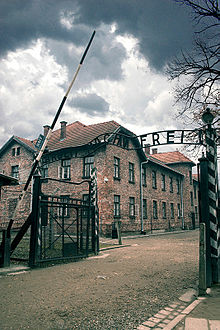Auschwitz-Birkenau State Museum

Entrance to Auschwitz I, 2014
|
|
| Established | April 1946, confirmed by an act of the Polish parliament on July 2, 1947 |
|---|---|
| Location | Oświęcim, Poland |
| Visitors | 1.72 million+ (2015) |
| Director | Piotr Cywiński |
| Website | http://auschwitz.org/en/ |
|
UNESCO World Heritage Site Auschwitz German Nazi concentration and extermination camp (1940–45) |
|
| Name as inscribed on the World Heritage List | |
| Location | Poland |
| Type | Cultural |
| Criteria | IV |
| Reference | 31 |
| UNESCO region | Europe and North America |
| Inscription history | |
| Inscription | 1979 (3rd Session) |
The Auschwitz-Birkenau Memorial and Museum (Polish: Państwowe Muzeum Auschwitz-Birkenau) is a memorial and museum in Oświęcim (German: Auschwitz), Poland, which includes the German concentration camps Auschwitz I and Auschwitz II-Birkenau. It is devoted to the memory of the murders in both camps during World War II. The museum performs several tasks, among them research into the Holocaust.
The museum was founded by resolution of the Polish parliament on July 2, 1947. Resolution of Polish parliament from 2 July 1947 determines:
The site of the former Nazi concentration camp in Auschwitz together with all the buildings and installations standing there is to be kept forever as a 'Monument to the Martyrology of the Polish Nation and other Nations'.
The area covers 191 hectares (470 acres), twenty of them in camp Auschwitz I and 171 hectares in camp Auschwitz II. Since 1979, the former concentration camp has belonged to the World Cultural Heritage and more than 25 million people have visited the museum. From 1955 to 1990, the museum was directed by one of its founders and former inmates, Kazimierz Smoleń.
The areas of remembrance are Auschwitz I, Auschwitz II-Birkenau, the train ramp between Auschwitz and Birkenau, which was used as a "debarkation-stop" between 1942–1944. The three kilometres between Auschwitz and Birkenau are within walking distance. The museum is situated in several original buildings.
The number of visitors has been increasing year by year. In 2006, more than one million people from 94 countries visited: from Poland (341,000), U.S. (96,000), UK (57,200), Italy (51,000), Germany (50,200), France (39,100), Israel (37,200), South Korea (35,400), Norway (30,600), and Spain (23,300).
There were 1.3 million visitors in 2009 and 1.38 million in 2010. In 2011, more than 1.4 million people from 111 countries visited: from Poland (610,000), United Kingdom (82,000), Italy (78,000), Israel (62,000), Germany (58,000), France (56,000), United States (52,000), Spain (46,000), South Korea, and Czech Republic (43,000 each).
...
Wikipedia
